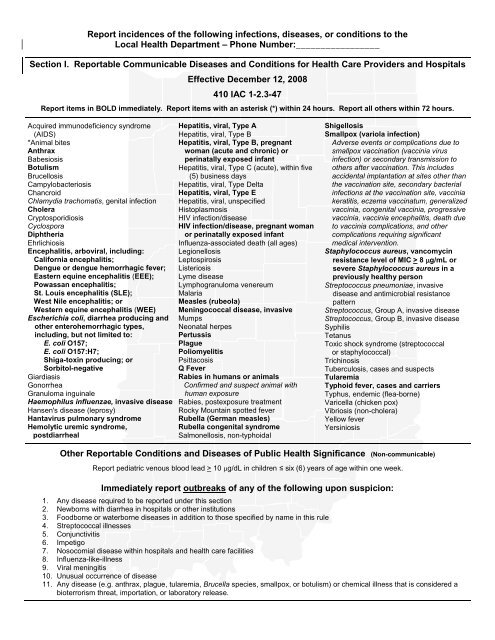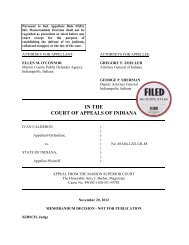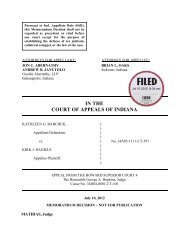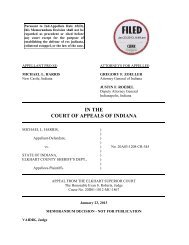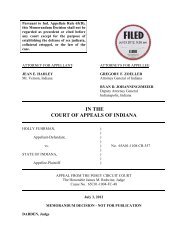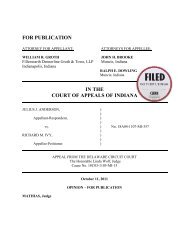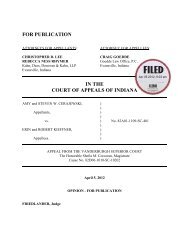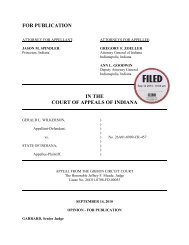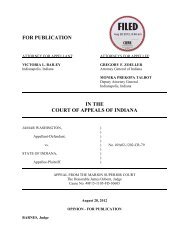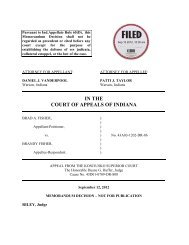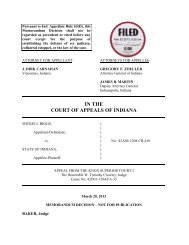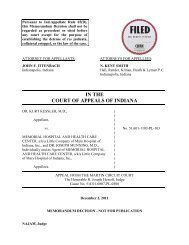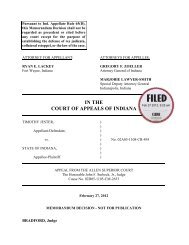Reportable Diseases List - State of Indiana
Reportable Diseases List - State of Indiana
Reportable Diseases List - State of Indiana
Create successful ePaper yourself
Turn your PDF publications into a flip-book with our unique Google optimized e-Paper software.
Report incidences <strong>of</strong> the following infections, diseases, or conditions to the<br />
Local Health Department – Phone Number:_________________<br />
Section I. <strong>Reportable</strong> Communicable <strong>Diseases</strong> and Conditions for Health Care Providers and Hospitals<br />
Effective December 12, 2008<br />
410 IAC 1-2.3-47<br />
Report items in BOLD immediately. Report items with an asterisk (*) within 24 hours. Report all others within 72 hours.<br />
Acquired immunodeficiency syndrome<br />
(AIDS)<br />
*Animal bites<br />
Anthrax<br />
Babesiosis<br />
Botulism<br />
Brucellosis<br />
Campylobacteriosis<br />
Chancroid<br />
Chlamydia trachomatis, genital infection<br />
Cholera<br />
Cryptosporidiosis<br />
Cyclospora<br />
Diphtheria<br />
Ehrlichiosis<br />
Encephalitis, arboviral, including:<br />
California encephalitis;<br />
Dengue or dengue hemorrhagic fever;<br />
Eastern equine encephalitis (EEE);<br />
Powassan encephalitis;<br />
St. Louis encephalitis (SLE);<br />
West Nile encephalitis; or<br />
Western equine encephalitis (WEE)<br />
Escherichia coli, diarrhea producing and<br />
other enterohemorrhagic types,<br />
including, but not limited to:<br />
E. coli O157;<br />
E. coli O157:H7;<br />
Shiga-toxin producing; or<br />
Sorbitol-negative<br />
Giardiasis<br />
Gonorrhea<br />
Granuloma inguinale<br />
Haemophilus influenzae, invasive disease<br />
Hansen's disease (leprosy)<br />
Hantavirus pulmonary syndrome<br />
Hemolytic uremic syndrome,<br />
postdiarrheal<br />
Hepatitis, viral, Type A<br />
Hepatitis, viral, Type B<br />
Hepatitis, viral, Type B, pregnant<br />
woman (acute and chronic) or<br />
perinatally exposed infant<br />
Hepatitis, viral, Type C (acute), within five<br />
(5) business days<br />
Hepatitis, viral, Type Delta<br />
Hepatitis, viral, Type E<br />
Hepatitis, viral, unspecified<br />
Histoplasmosis<br />
HIV infection/disease<br />
HIV infection/disease, pregnant woman<br />
or perinatally exposed infant<br />
Influenza-associated death (all ages)<br />
Legionellosis<br />
Leptospirosis<br />
<strong>List</strong>eriosis<br />
Lyme disease<br />
Lymphogranuloma venereum<br />
Malaria<br />
Measles (rubeola)<br />
Meningococcal disease, invasive<br />
Mumps<br />
Neonatal herpes<br />
Pertussis<br />
Plague<br />
Poliomyelitis<br />
Psittacosis<br />
Q Fever<br />
Rabies in humans or animals<br />
Confirmed and suspect animal with<br />
human exposure<br />
Rabies, postexposure treatment<br />
Rocky Mountain spotted fever<br />
Rubella (German measles)<br />
Rubella congenital syndrome<br />
Salmonellosis, non-typhoidal<br />
Shigellosis<br />
Smallpox (variola infection)<br />
Adverse events or complications due to<br />
smallpox vaccination (vaccinia virus<br />
infection) or secondary transmission to<br />
others after vaccination. This includes<br />
accidental implantation at sites other than<br />
the vaccination site, secondary bacterial<br />
infections at the vaccination site, vaccinia<br />
keratitis, eczema vaccinatum, generalized<br />
vaccinia, congenital vaccinia, progressive<br />
vaccinia, vaccinia encephalitis, death due<br />
to vaccinia complications, and other<br />
complications requiring significant<br />
medical intervention.<br />
Staphylococcus aureus, vancomycin<br />
resistance level <strong>of</strong> MIC > 8 µg/mL or<br />
severe Staphylococcus aureus in a<br />
previously healthy person<br />
Streptococcus pneumoniae, invasive<br />
disease and antimicrobial resistance<br />
pattern<br />
Streptococcus, Group A, invasive disease<br />
Streptococcus, Group B, invasive disease<br />
Syphilis<br />
Tetanus<br />
Toxic shock syndrome (streptococcal<br />
or staphylococcal)<br />
Trichinosis<br />
Tuberculosis, cases and suspects<br />
Tularemia<br />
Typhoid fever, cases and carriers<br />
Typhus, endemic (flea-borne)<br />
Varicella (chicken pox)<br />
Vibriosis (non-cholera)<br />
Yellow fever<br />
Yersiniosis<br />
Other <strong>Reportable</strong> Conditions and <strong>Diseases</strong> <strong>of</strong> Public Health Significance (Non-communicable)<br />
Report pediatric venous blood lead > 10 µg/dL in children ≤ six (6) years <strong>of</strong> age within one week.<br />
Immediately report outbreaks <strong>of</strong> any <strong>of</strong> the following upon suspicion:<br />
1. Any disease required to be reported under this section<br />
2. Newborns with diarrhea in hospitals or other institutions<br />
3. Foodborne or waterborne diseases in addition to those specified by name in this rule<br />
4. Streptococcal illnesses<br />
5. Conjunctivitis<br />
6. Impetigo<br />
7. Nosocomial disease within hospitals and health care facilities<br />
8. Influenza-like-illness<br />
9. Viral meningitis<br />
10. Unusual occurrence <strong>of</strong> disease<br />
11. Any disease (e.g. anthrax, plague, tularemia, Brucella species, smallpox, or botulism) or chemical illness that is considered a<br />
bioterrorism threat, importation, or laboratory release.
Report incidences <strong>of</strong> the following infections, diseases, or conditions to the<br />
<strong>Indiana</strong> <strong>State</strong> Department <strong>of</strong> Health (ISDH)<br />
Telephone: 317.233.7125 or Facsimile: 317.234.2812<br />
Section II. Medical Laboratory Reporting<br />
Effective December 12, 2008<br />
410 IAC 1-2.3-48<br />
Report laboratory findings demonstrating evidence <strong>of</strong> the following infections, diseases, or conditions at least weekly.<br />
Arboviruses, including, but not limited to:<br />
California encephalitis;<br />
Dengue or dengue hemorrhagic fever;<br />
Eastern equine encephalitis (EEE);<br />
Japanese B encephalitis;<br />
Powassan encephalitis;<br />
St. Louis encephalitis (SLE);<br />
West Nile encephalitis;<br />
Western equine encephalitis (WEE); or<br />
Yellow fever<br />
Babesia species<br />
Bacillus anthracis<br />
Bordetella pertussis<br />
Borrelia burgdorferi<br />
Brucella species<br />
Calymmatobacterium granulomatis<br />
Campylobacter species<br />
Chlamydia psittaci<br />
Chlamydia trachomatis<br />
Clostridium botulinum<br />
Clostridium tetani<br />
Corynebacterium diphtheriae<br />
Coxiella burnetii<br />
Cryptococcus ne<strong>of</strong>ormans<br />
Cryptosporidium parvum<br />
Cyclospora cayetanensis<br />
Ehrlichia chaffeensis<br />
Ehrlichia phagocytophila<br />
Escherichia coli, diarrhea producing and<br />
other enterohemorrhagic types,<br />
including, but not limited to:<br />
E. coli O157;<br />
E. coli O157:H7;<br />
Shiga-toxin producing; or<br />
Sorbitol-negative<br />
Francisella tularensis<br />
Giardia lamblia<br />
Haemophilus ducreyi<br />
Haemophilus influenzae, invasive disease<br />
Hantavirus<br />
Hepatitis viruses:<br />
Anti-HAV IgM;<br />
HBsAg, HBeAg, or IgM anti-HBc;<br />
RIBA, RNA, or anti-HCV (or any<br />
combination);<br />
Delta; or<br />
Anti-HEV IgM or IgG<br />
Herpes simplex virus (neonatal)<br />
Histoplasmosis capsulatum<br />
HIV and related retroviruses<br />
Influenza<br />
Kaposi’s sarcoma (biopses)<br />
Legionella species<br />
Leptospira species<br />
<strong>List</strong>eria monocytogenes<br />
Measles virus<br />
Mumps virus<br />
Mycobacterium tuberculosis<br />
Neisseria gonorrhoeae<br />
Neisseria meningitidis, invasive disease<br />
Nocardia species and antimicrobial<br />
resistance pattern<br />
Plasmodium species<br />
Pneumocystis carinii<br />
Poliomyelitis<br />
Rabies virus (animal or human)<br />
Rickettsia species<br />
Rubella virus<br />
Salmonella species<br />
Shigella species and<br />
antimicrobial resistance pattern<br />
Smallpox<br />
Staphylococcus aureus, vancomycin<br />
resistance level <strong>of</strong> MIC ≥ 8 µg/mL<br />
Streptococcus pneumoniae, invasive<br />
disease, and antimicrobial resistance<br />
pattern<br />
Streptococcus Group A<br />
(e.g. Streptococcus pyogenes), invasive<br />
disease<br />
Streptococcus Group B,<br />
(e.g. Streptococcus agalactiae), invasive<br />
disease<br />
Treponema pallidum<br />
Trichinella spiralis<br />
Vibrio species<br />
Yersinia species, including:<br />
pestis;<br />
enterocolitica; or<br />
pseudotuberculosis<br />
Reporting is required <strong>of</strong> any specimen derived from the human body that yields microscopic, bacteriologic, immunologic,<br />
serologic, or other evidence <strong>of</strong> infection by any <strong>of</strong> the organisms or agents listed.<br />
Reporting shall include the following epidemiological and testing data:<br />
1. Name, date, results <strong>of</strong> test performed, the laboratory’s normal limits for the test, the laboratory’s interpretation <strong>of</strong> the test<br />
results, and the laboratory’s accession number or other numeric identifier<br />
2. Name, address, and date <strong>of</strong> birth or age, if date <strong>of</strong> birth is not available, <strong>of</strong> the person from whom the specimen was obtained<br />
3. Name, address, and telephone number <strong>of</strong> attending physician, hospital, clinic, or other specimen submitter<br />
4. Name, address, telephone number, and CLIA ID number <strong>of</strong> the laboratory performing the test<br />
Laboratories shall submit all isolates <strong>of</strong> the following organisms to the ISDH Laboratory for further evaluation within five (5)<br />
business days <strong>of</strong> isolation:<br />
1. Haemophilus influenzae, invasive disease<br />
2. Neisseria meningitidis, invasive disease<br />
3. Escherichia coli O157:H7; shiga-toxin producing; or sorbitol-negative E. coli isolates<br />
4. Staphylococcus aureus, vancomycin resistance level <strong>of</strong> MIC ≥ 8 µg/mL<br />
5. Mycobacterium tuberculosis<br />
6. Streptococcus pneumoniae, invasive disease, isolates from persons less than five (5) years <strong>of</strong> age<br />
7. Nocardia<br />
8. <strong>List</strong>eria monocytogenes<br />
9. Salmonella isolates from stool, urine, blood, or other sterile sites


